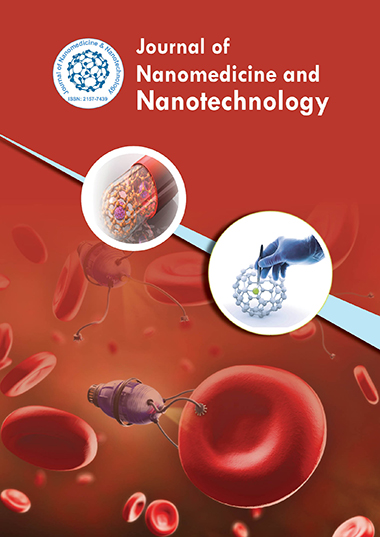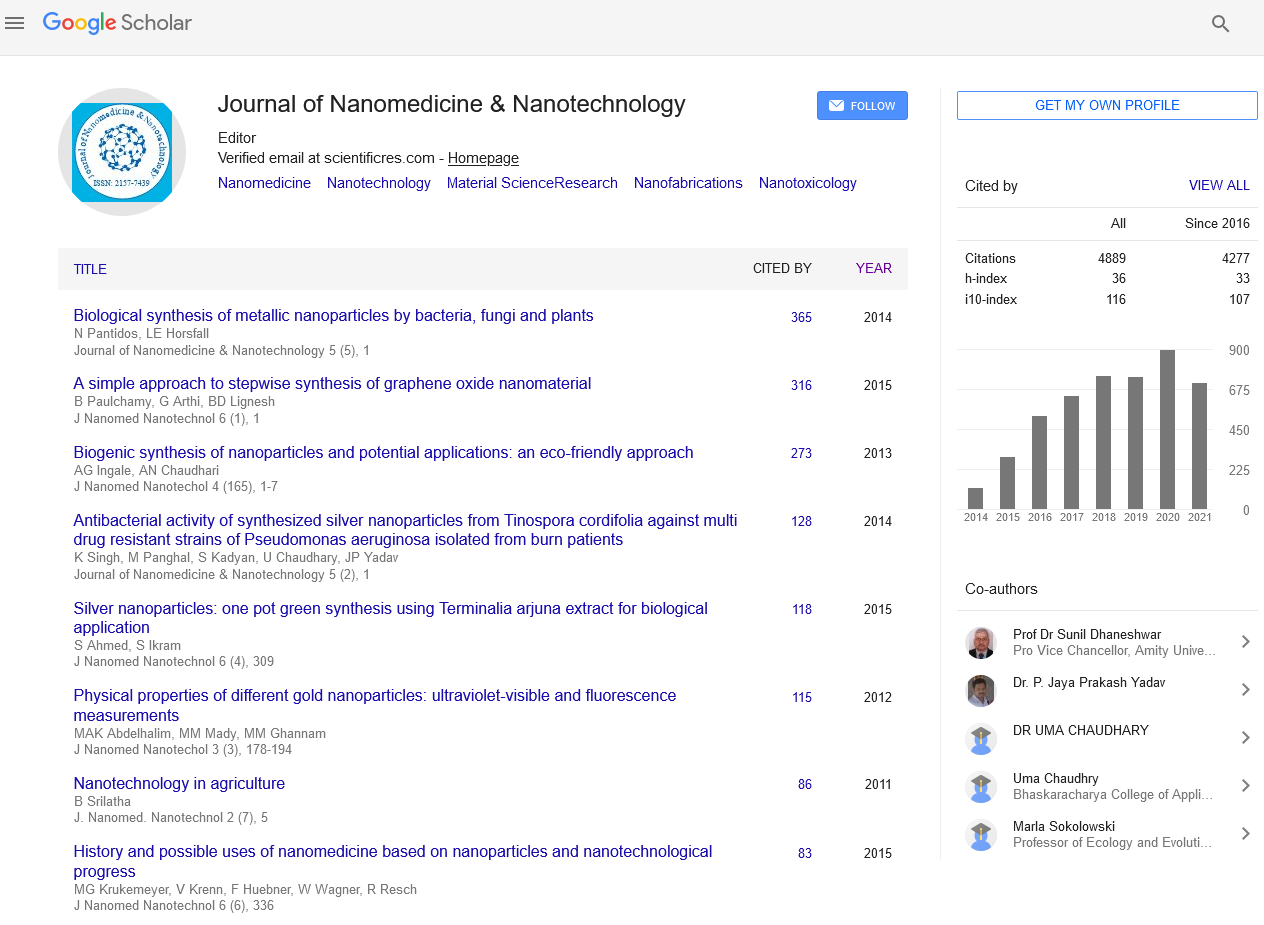Indexed In
- Open J Gate
- Genamics JournalSeek
- Academic Keys
- JournalTOCs
- ResearchBible
- China National Knowledge Infrastructure (CNKI)
- Scimago
- Ulrich's Periodicals Directory
- Electronic Journals Library
- RefSeek
- Hamdard University
- EBSCO A-Z
- OCLC- WorldCat
- SWB online catalog
- Virtual Library of Biology (vifabio)
- Publons
- MIAR
- Scientific Indexing Services (SIS)
- Euro Pub
- Google Scholar
Useful Links
Share This Page
Journal Flyer

Open Access Journals
- Agri and Aquaculture
- Biochemistry
- Bioinformatics & Systems Biology
- Business & Management
- Chemistry
- Clinical Sciences
- Engineering
- Food & Nutrition
- General Science
- Genetics & Molecular Biology
- Immunology & Microbiology
- Medical Sciences
- Neuroscience & Psychology
- Nursing & Health Care
- Pharmaceutical Sciences
Review Article - (2024) Volume 15, Issue 3
Unveiling a Membrane Protein-Guided and ATP-Gated Dual Module DNA Nanodevice: Revolutionizing Fluorescent Labeling of Cancer Cells
Mohamed Elbaz*Received: 01-May-2024, Manuscript No. jnmnt-24-25956; Editor assigned: 04-May-2024, Pre QC No. jnmnt-24-25956(PQ); Reviewed: 18-May-2024, QC No. jnmnt-24-25956(QC); Revised: 25-May-2024, Manuscript No. jnmnt-24-25956(R); Published: 31-May-2024, DOI: 10.35248/2157-7439.24.15.734.
Abstract
In the realm of nanotechnology, the development of innovative tools for the precise detection and characterization of cancer cells is paramount. Among these, the membrane protein-guided and ATP-gated dual module DNA nanodevice emerges as a revolutionary technology with the potential to transform fluorescent labeling of cancer cells. This article explores the intricacies and implications of this groundbreaking nanodevice, which combines the targeting specificity of membrane proteins with the signal amplification capacity of adenosine triphosphate (ATP)-gated modules. By precisely engineering molecular interactions, researchers have created a versatile nanodevice capable of selectively targeting and labeling cancer cells with enhanced sensitivity and specificity. The modular design of the nanodevice allows for customization to suit different cancer types and molecular targets, opening up new avenues for personalized cancer diagnosis and treatment. As this technology continues to evolve, its potential to revolutionize cancer detection and therapy is poised to make a significant impact on the field of oncology.
Keywords
Nanotechnology, DNA nanodevice, Membrane proteins, ATP-gated module, Fluorescent labeling, Cancer cells
INTRODUCTION
In the dynamic landscape of nanotechnology, the quest for innovative tools to combat cancer has led to the development of advanced nanodevices with unparalleled precision and functionality. Among these, the membrane protein-guided and ATP-gated dual module DNA nanodevice stands out as a revolutionary technology poised to transform the landscape of cancer diagnosis and treatment [1,2]. This article unveils the intricacies and implications of this groundbreaking nanodevice, highlighting its potential to revolutionize the fluorescent labeling of cancer cells. Nanotechnology has long been recognized as a promising avenue for enhancing cancer detection and treatment. The ability to engineer nanoscale devices with precise targeting capabilities holds immense potential for improving the specificity and sensitivity of cancer diagnostics [3,4]. In this context, the membrane protein-guided and ATP-gated dual module DNA nanodevice represents a paradigm shift in nanotechnology-driven approaches to cancer detection. At the core of this nanodevice lies a sophisticated dual module system guided by membrane proteins and activated by adenosine triphosphate (ATP). Membrane proteins, strategically engineered to target cancer cell membranes, serve as the guiding force for the nanodevice, ensuring precise localization and interaction with cancer cells. Meanwhile, ATP acts as the molecular trigger, gating the activation of the nanodevice and initiating the fluorescent labeling process [5,6]. The integration of membrane protein guidance and ATP-gated activation endows the nanodevice with remarkable specificity and sensitivity in targeting and labeling cancer cells. By harnessing the unique properties of membrane proteins and the signal amplification capacity of ATP-gated modules, researchers can achieve highly selective and sensitive fluorescent labeling of cancer cells, paving the way for improved cancer diagnostics and personalized treatment strategies [7,8]. Furthermore, the modular design of the nanodevice offers versatility and adaptability, allowing for customization to suit different cancer types and molecular targets. This modularity enables researchers to tailor the nanodevice to address the unique challenges and characteristics of diverse cancer cell populations, opening up new avenues for precision medicine and targeted therapy. In the dynamic landscape of nanotechnology, the quest for innovative tools to diagnose and treat diseases, particularly cancer, has led to the development of advanced nanodevices. Among these, the membrane protein-guided and ATP-gated dual module DNA nanodevice stands out as a remarkable innovation [9,10]. This article delves into the intricacies and implications of this groundbreaking nanotechnology, shedding light on its potential to revolutionize the fluorescent labeling of cancer cells.
Exploring the dual module DNA nanodevice
At the heart of this nanodevice lies a sophisticated dual module system guided by membrane proteins and activated by adenosine triphosphate (ATP). Membrane proteins, strategically engineered to target cancer cell membranes, serve as the guiding force for the nanodevice, ensuring precise localization and interaction with cancer cells. Meanwhile, ATP acts as the molecular trigger, gating the activation of the nanodevice and initiating the fluorescence labeling process. The design and construction of this dual module DNA nanodevice represent a convergence of interdisciplinary expertise, combining principles of molecular biology, nanotechnology, and biochemistry. Through precise engineering of DNA sequences and membrane protein interactions, researchers have created a versatile nanodevice capable of specifically targeting cancer cells and amplifying fluorescence signals for enhanced detection.
Enhanced fluorescent labeling of cancer cells
One of the most promising applications of the membrane protein-guided and ATP-gated dual module DNA nanodevice lies in its ability to enhance fluorescent labeling of cancer cells. Traditional fluorescent labeling techniques often suffer from limitations such as nonspecific binding and low signal-to-noise ratios. However, by harnessing the targeting specificity of membrane proteins and the signal amplification capacity of ATP-gated nanodevices, researchers can achieve highly sensitive and selective labeling of cancer cells. The nanodevice operates through a series of precisely orchestrated molecular interactions. Upon encountering cancer cell membranes, the membrane protein-guided nanodevice binds to specific receptors, initiating a cascade of events that culminate in the activation of the ATP-gated module. Subsequent ATP binding triggers a conformational change in the nanodevice, leading to the release of fluorescent probes and the generation of amplified fluorescence signals localized to cancer cells.
Implications for cancer diagnosis and treatment
The membrane protein-guided and ATP-gated dual module DNA nanodevice holds immense potential for applications in cancer diagnosis and treatment. By providing a highly sensitive and selective means of fluorescent labeling, this nanodevice enables researchers to visualize and characterize cancer cells with unprecedented clarity and precision. Moreover, the ability to target specific membrane proteins associated with cancer cells opens up opportunities for targeted drug delivery and therapy. Furthermore, the modular nature of this nanodevice allows for customization and optimization to suit specific cancer types and molecular targets. By engineering different membrane protein guides and tuning ATP-gated activation mechanisms, researchers can tailor the nanodevice to address the unique challenges and characteristics of different cancer cell populations.
CONCLUSION
The membrane protein-guided and ATP-gated dual module DNA nanodevice represents a groundbreaking advancement in the field of nanotechnology, offering a novel approach to fluorescent labeling of cancer cells. Through precise molecular engineering and interdisciplinary collaboration, researchers have created a versatile nanodevice capable of targeting cancer cells with high specificity and sensitivity. As this technology continues to evolve, its potential applications in cancer diagnosis and treatment are boundless, paving the way for transformative advancements in the fight against cancer.
REFERENCES
- Li Z, Zhang Y, Fullston D, Shen Y. Advanced carbon-based nanomaterials for tumor photothermal therapy. Nanomaterials. 2021;11(5): 1137.
- Xia Q, Cai Y, Zheng J, Zhang J. Nanomaterials-based photothermal therapy and its potentials in antibacterial treatment. Journal of Controlled Release. 2021;330: 75-90.
- Narayanan, K B, Sakthivel N. Green synthesis of biogenic metal and metal oxide nanoparticles and their effect on the bioactivity of pharmaceuticals. Journal of Molecular Liquids. 2020;300: 112202.
- Brown S A, Hansbro, P M, Hansbro, N G. Animal models of asthma: value, limitations and opportunities for alternative approaches. Drug Discovery Today. 2019;24(1): 206-218.
- Jones, J R, Barrère F, van Blitterswijk, C A. Calcium phosphate ceramics as bone graft substitutes in filling bone tumors. Pharmaceuticals. 2020;3(3): 125.
- Wang Y, Qi X, Lu L, Xu X. Anticancer properties of sulfated chitosan. Biol Trace Elem Res. 2019;192(2): 205-212.
- Li J, Wang X, Zhang T, Wang C, Huang Z, Luo et al . Polypyrrole/chitosan-coated Fe3O4 nanoparticles for MRI-guided photothermal cancer therapy. Biomedical Materials. 2020;15(4): 045001.
- Sharma N, Baldi A, Garg S. Cyclodextrins: encapsulation of drugs. Critical Reviews in Therapeutic Drug Carrier Systems. 2019;19(3): 185-208.
- Narayanan N, Sudhakumari C C. Cyclodextrin as a tool in enhanced drug delivery. Polym Renew Resour. 2021;10(2): 77-84.
- Smith, K A, Buhro, W E. Synthesis of surface-stabilized beta-cyclodextrin/gold nanoparticle assemblies. Nanoscale Advances. 2020;2(2): 527-535.
Indexed at, Google Scholar, Cross Ref
Indexed at, Google Scholar, Crossref
Indexed At, Google Scholar, Crossref
Indexed At, Google Scholar, Crossref
Indexed at, Google Scholar, Crossref
Indexed at, Google Scholar, Crossref
Indexed At, Google Scholar, Crossref
Indexed at, Google Scholar, Crossref
Citation: Mohamed E (2024) Unveiling a Membrane Protein-Guided and ATP-Gated Dual Module DNA Nanodevice: Revolutionizing Fluorescent Labeling of Cancer Cells. J Nanomed Nanotech. 15: 734.
Copyright: ©2024 Mohamed E. This is an open-access article distributed under the terms of the Creative Commons Attribution License, which permits unrestricted use, distribution, and reproduction in any medium, provided the original author and source are credited.


